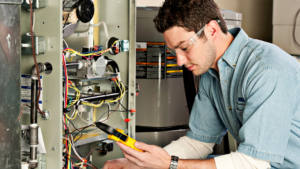 Most furnaces are gas-powered. Gas fuels the burners inside the heat exchanger, which warms the air being circulated through your home. Heating systems can run without gas, but they can’t generate heat. Cold air blowing from your vents is normally one of the first signs your furnace gas valve is bad.
Most furnaces are gas-powered. Gas fuels the burners inside the heat exchanger, which warms the air being circulated through your home. Heating systems can run without gas, but they can’t generate heat. Cold air blowing from your vents is normally one of the first signs your furnace gas valve is bad.
Gas valves generally go bad after many years of regular use, through ordinary wear and tear. In some cases, seepage can cause the valve to rust or become blocked. A valve doesn’t even have to be blocked completely to cause trouble. Partially blocked valves prevent the furnace from generating enough heat to warm your house, causing it to run endlessly throughout the day.
Besides increasing your energy bills, this constant cycling can overtax the motor ‒ leading to more expensive problems down the line. Worse, a faulty valve can leak gas into your home and endanger the health of your family. Given its importance, learning to recognize the signs of a bad gas valve will help keep your family and your home safe, snug, and warm all winter long.
Signs Your Furnace Gas Valve is Bad
Furnace components activate sequentially, so once you know how the system works, determining the source of the problem is relatively easy. The process starts with the thermostat. It triggers the draft inducer, a fan that draws combustion air into the furnace. After running for about thirty seconds, to vent the combustion chamber, the inducer’s pressure switch activates the igniter.
To create a steady, controlled burn, the igniter sparks before gas starts flowing into the combustion chamber. Then, finally, the gas valve opens and supplies the burners. The burners ignite and warm the heat exchanger, which pushes hot air through the vents and out into the various rooms of your home.
Because each component has a specific order of operations, determining which one is malfunctioning is fairly straightforward. For instance, if you hear the inducer fan start up, but not the ignitor, the igniter is the problem. However, if you hear the igniter spark continuously, then the gas valve is the problem.
Fixing a Gas Valve
Unless you have experience working with HVAC systems, attempting to repair a furnace on your own usually leads to problems, such as:
- Lasting Damage. Unless you’re familiar with them, tinkering with complex, mechanical devices is never a good idea. It might not only cause further harm, you may leave behind crossed wires or loose connections. Often, homeowners install replacement parts that are incompatible with their unit, which can destabilize the system and cause a breakdown. In the worst case, the entire system may have to be replaced.
- Electric Shock. Furnaces communicate through electrical signals carried along live wires. Mishandling wiring or working without proper safety equipment can cause serious injury.
- Gas Leaks. A poorly sealed valve can release small amounts of gas into your home, resulting in dizziness, fatigue, headaches, and shortness of breath.
- Explosions. Gas leaks can spark fires. For this reason, some states forbid anyone from working on a furnace without proper training.
Before You Call a Professional
Homeowners who suspect their furnace valve is bad should call an HVAC contractor. However, before picking up the phone, there are a few steps you can take to resolve the issue on your own. First, check the electrical switch that controls the valve. If it’s off, turn it on. There should be a label indicating which is the correct position. Examine the thermostat as well. It’s not uncommon for a family member to adjust the settings without informing the rest of the household.
Save on Repairs with Agway
A bad furnace valve is a health and safety hazard. When the need for repair occurs, Agway customers don’t waste time searching for a qualified repairman. They turn to us instead. Our EnergyGuardTM Program provides repairs for damage caused by wear and tear.
Repairing and replacing worn parts can cost hundreds of dollars. EnergyGuardTM helps shoulder those burdens and keep your monthly budget on track. When an issue arrives, we send out a local contractor as soon as possible and pay for all covered parts. There are no service fees or deductibles either. Just reliable, year-round support. Contact us today to learn more!